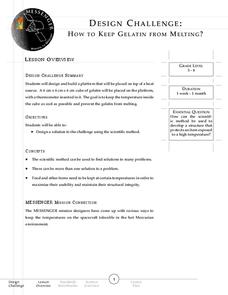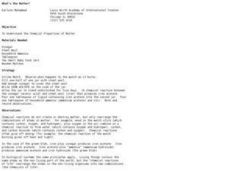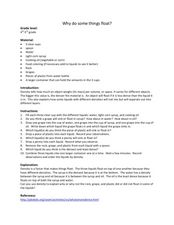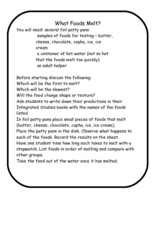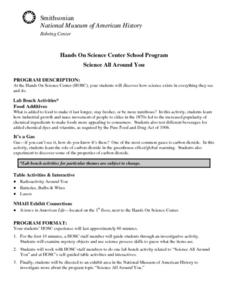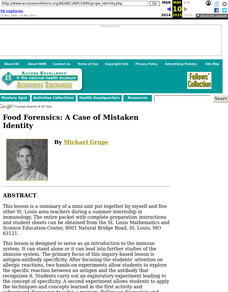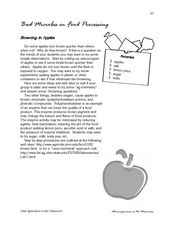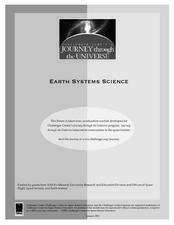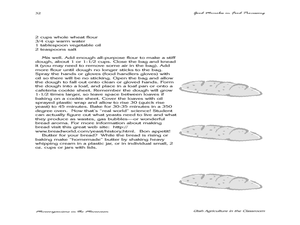Messenger Education
Design Challenge: How to Keep Gelatin from Melting
The inside of the spacecraft Messenger, which explores Mercury, will experience temperatures from 32 to 91 degrees Fahrenheit. In the final installment of a series of four space-related activities, groups spend time discussing and...
American Museum of Natural History
Fascinating Fish
A fish is not just a fish. So many fish in remote places have unique characteristics. Take a trip with an ichthyologist to the Congo River to discover the species of one of the most diverse fish populations in the world. The online...
Curated OER
What's the Matter? (Living and Non-Living Things)
Understand how chemical reactions recombine atoms to create the "chemicals of life". An experiment, showing the basic chemical reactions of an iron nail or a match, helps young children start their understanding of permanent changes.
Curated OER
Biodegradable Plastics
Sixth graders explore the many uses of corn as a renewable source. In this biodegradable resource lesson, 6th graders investigate how corn is used in manufacturing and as a fuel. Students construct a piece of homemade plastic using...
Curated OER
Why Do Some Things Float?
Students recognize that density determines whether objects sink or float. In this sink or float lesson, students experiment with plastic in three liquids. students drop their objects into the liquids and observe and record their results.
Curated OER
Experiences and Experiments - There is a Difference
Sixth graders plan and conduct an experiment on food spoilage. They design the experiment, create a display, record and analyze data, and make inferences regarding the results of the experiment.
Curated OER
Where do Plants Get their Food?
In this where do plants get their food worksheet, students design an experiment that will disprove the idea that plants obtain their food from soil. Students will set up their experiment and design a data table that will record data over...
Curated OER
What Foods Melt?
In this science worksheet, students experiment to determine which foods melt using hot water in metal pans. They write predictions about which foods will melt and which will melt the fastest. They perform the experiment and note the what...
Curated OER
Matters of Milk and Marshmallows
Pupils observe a teacher demonstration o classifying matter by its physical properties of shape and size. After discussing the definition of matter, students describe the state of matter. They sing a song to the tune of "Bingo." In...
Curated OER
Algae Experiments
Students describe the characteristics of algae. In this biology lesson, students perform a series of experiment to explore algae. They investigate the basic things algae need to survive.
Curated OER
Science All Around You
Students visit and explore a Hands On Science Center (HOSC). They participate in a variety of self-guided table exercises and observe as scientists demonstrate various scientific principles.
Curated OER
Food Forensics: A Case of Mistaken Identity
Ninth graders explore the specific reaction between an antigen and the antibody that recognizes it. They carry out an exploratory experiment leading to the concept of specificity.
Curated OER
Bad Microbes in Food Processing
Students complete an experiment to determine if there are bad microbes in food processing.In this bad microbe experiment, students use apples to see how they react to oxygen. Students test apples with chemicals to observe the changes.
Curated OER
Physical and Chemical Changes in Food
Ninth graders study food mixtures and substances in order to identify atoms, molecules, elements, and compounds and recognize physical changes that take place in foods.
Curated OER
The Radish Experiment
First graders grow radishes. In this Science lesson, 1st graders observe the growth of radishes in both the light and dark. Students discuss what plants need to live.
Curated OER
The Lipstick Experiment
In this scientific method instructional activity, students read "The Lipstick Experiment" and then complete the 2 student tasks on the instructional activity. They then answer the 5 questions regarding what they just read. The answers...
Curated OER
Earth Systems Science
Students perform experiments designed to grow plants and bacteria in a controlled environment. For this ecosystems lesson students investigate varying conditions for growing plants and bacteria.
Curated OER
Good Microbes in Food Processing
Students participate in a bread making experiment to understand the good microbes in bread. In this bread making lesson, students prepare bread in a bag with varied recipes and note results.
Curated OER
Food Preservation
Students examine the variety of food preservation methods available today. In groups, they participate in an experiment to determine the conditions that encourage or stop the growth of bacteria. To end the lessons, they discuss the...
Curated OER
Life Science - Seeds
Fourth graders participate in a scientific experiment involving growing lima beans. Students plot information gathered on included charts and graphs. Students use the steps of the scientific method throughout this experiment.
Curated OER
Cody's Science Education Zone
Students observe a scientific experiment and pose a hypothesis. For this scientific inquiry lesson, students make predictions about the combination of alcohol in water and how it will affect a floating ice cube.
Curated OER
Water Pollution Experiments
Fifth graders conduct experiments in simulated water pollution using a box of items to hold "pollutants"and an aquarium, representing a waterway. They observe how "rain" from a watering can poured into the box washes the pollutants into...
Curated OER
Experimenting with Yeast Metabolism
Ninth graders determine the rate of respiration by yeast and which sugars can be used as a food source by yeast using a CO2 gas sensor and computer software. This instructional activity is for an honors Biology class.
Curated OER
Spider Activities, Experiments and Projects
Students examine seven spiders and put them into two or three groups based on their structural similarities. In groups, they create a cladogram proposing possible ancestral relationships. Students design an experiment related to their...


